</p>
RE{CODE} is an urban simulation platform that modifies the existing fabric to minimize the social and economic imbalances in cities, through a protocol, for reprogramming based on patterns and performance relationships of urban dynamics.
//Context
In the next 30 years, only a third of the population in the world will not be living in urban areas. The unprecedented expansion of cities has presented many challenges, both global and territorial. A prominent bottleneck has been the steady, yet polarized, increase in demand and distribution of land, material, services, and energy. This skewed distribution results in the gentrification of vulnerable communities, dispersion of less resilient populations, and segregation within different strata of the society. Although this is the observed trend, the underlying cause is the socio-economic equality or inequality, which are the imbalances of social, economic, and spatial parameters between groups of populations that result in exclusion from adequate opportunities of growth thereby threatening the wellbeing of the city.
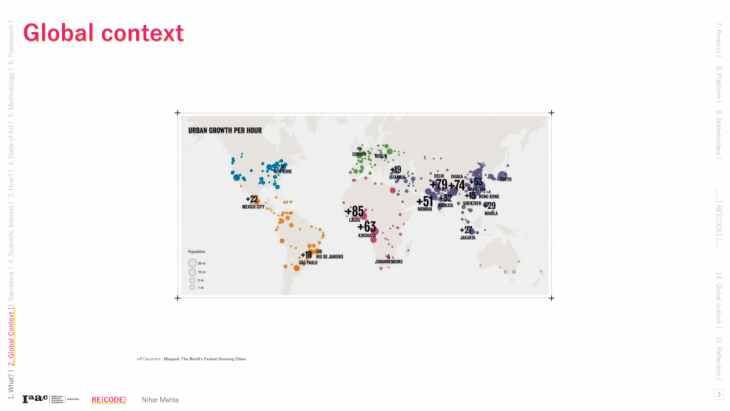
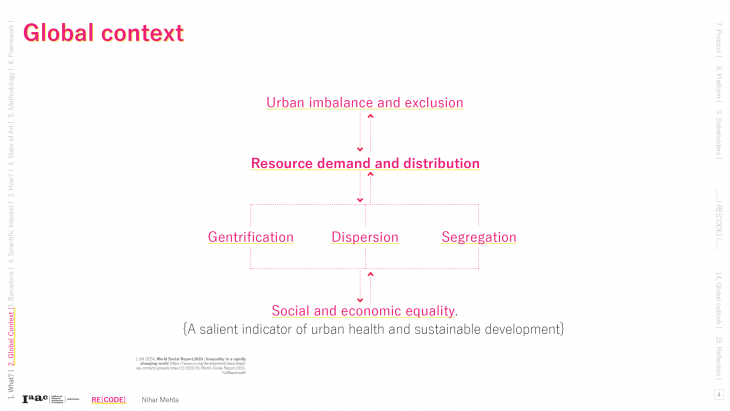
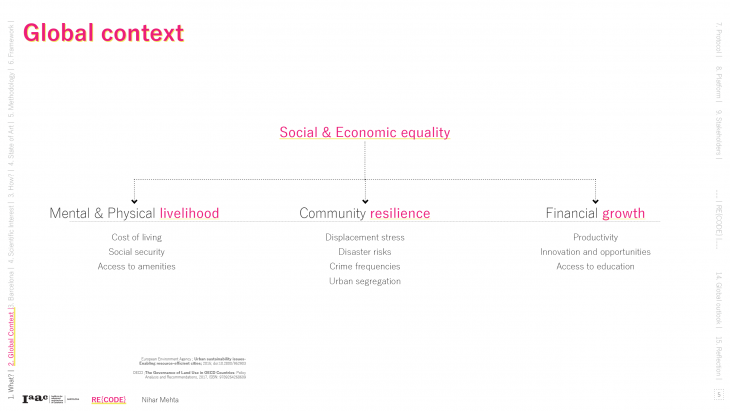
This equality is influenced by and influences many characteristics of city life, like mental and physical livelihood of people dictating access to social services and amenities, the resilience of communities against displacement, crime, and disasters, and lastly influencing peoples financial growth in terms of access to education and job opportunities.
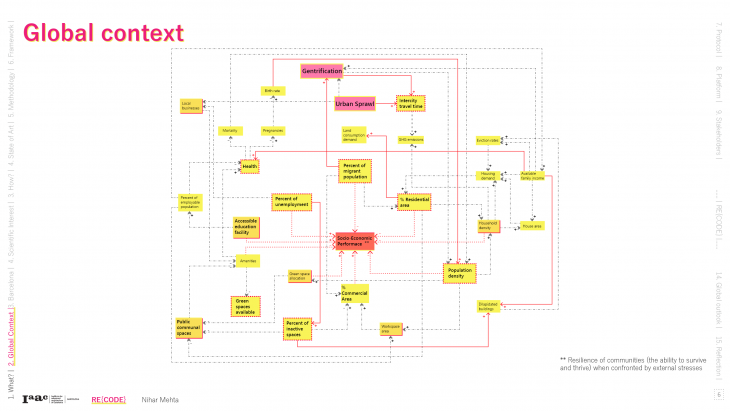
These are in a circular and propagating chain of direct and indirect causes and effects between urban dynamics, even the ones seemingly exclusive. Thus we must strongly consider strategies through the lens of such indicators and decouple urban planning from a strictly land use and zoning sense.
This is made more evident through a clustering study done using such indicators. This map helps visualize the city, not as the fabric of land use and zoning, but one based on its operation and performance.
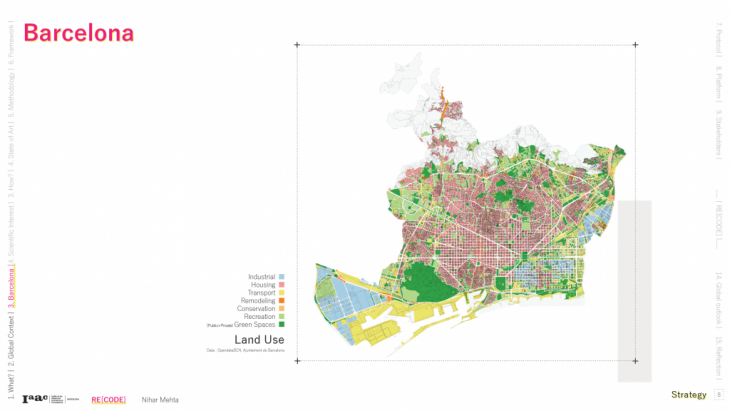
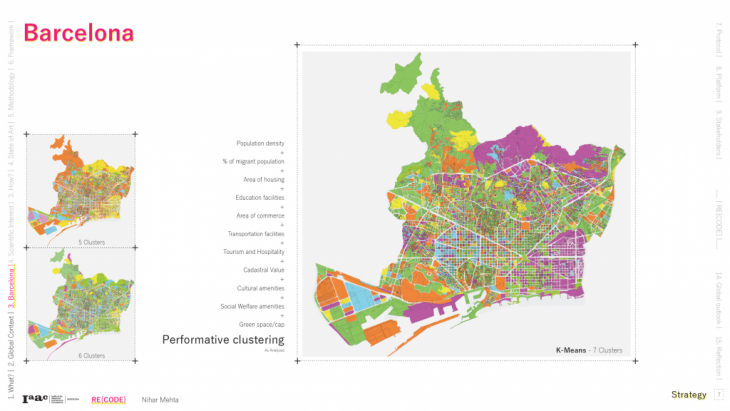
//Framework
The project closely observes the frameworks by the UN department of economic and social affairs that stipulates policies to ensure equal opportunities and eliminate discriminatory practices. Additionally, following the framework by European environmental to identify patterns of resource consumption and urban compactness and OECD’s report on economic impacts of spatial development and urban adequacy.
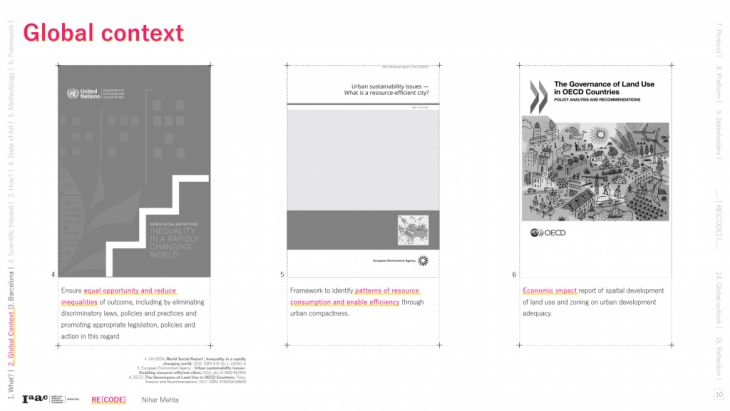
//Scientific Interest
How we can alter urban planning conventions through re-composition within cities to improve social and economic balance?
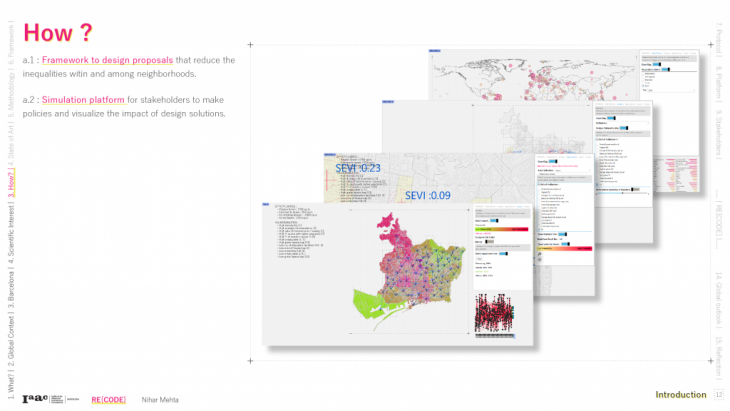
This project aims to address this by creating a framework to design proposals that reduce inequalities within and among neighborhoods. And further developing a simulation platform for stakeholders to craft policies and proposals and visualize their impacts.
Different strategies at all scales of regional, territorial and interventional must be considered for a comprehensive decision-making process. I’ve chosen to incorporate policy tools of working with enterprises, planning tools of infrastructure decision making, encouraging development for vulnerable people, analytical evaluation of indicators along with design tools of refurbishment, and urban compactness.
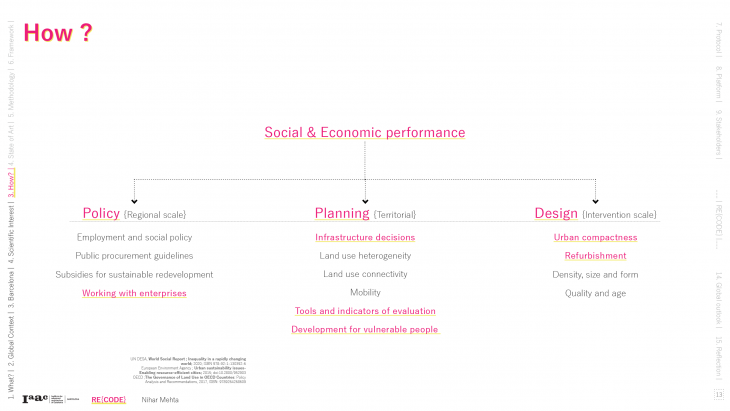
//State of the Art
East New York rezoning and Superblock Barcelona tackle inadequacy for vulnerable communities through the addition of interventions whereas Co-Housing Barcelona looks at an alternative to traditional consumption of housing to increase its accessibility. Archistar and Metricmonkey are platforms that facilitate the generation of design and evaluation of its execution feasibility whereas Morphocode enables analysis of existing urban conditions.
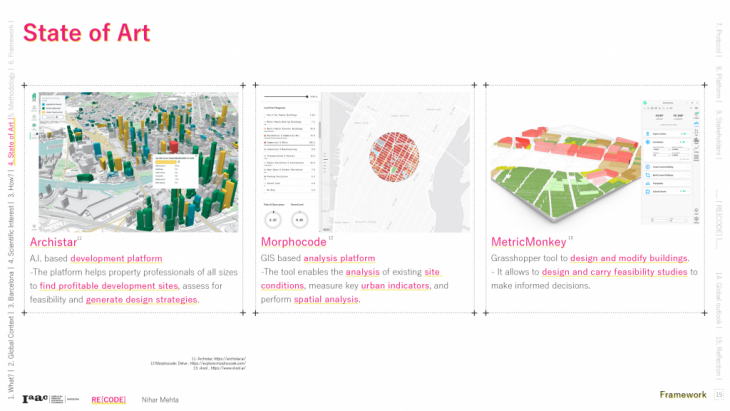
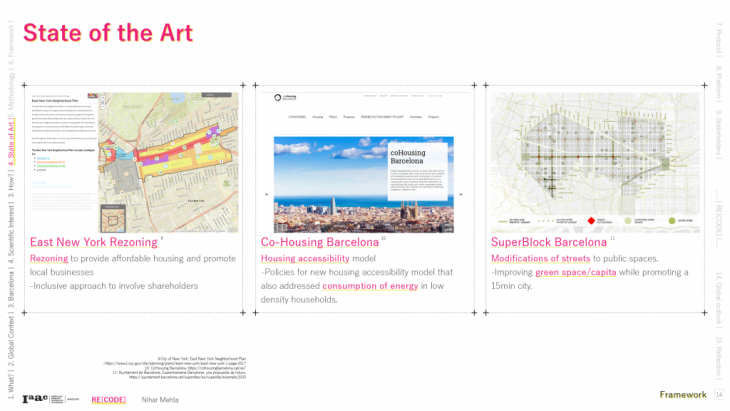
//Methodology
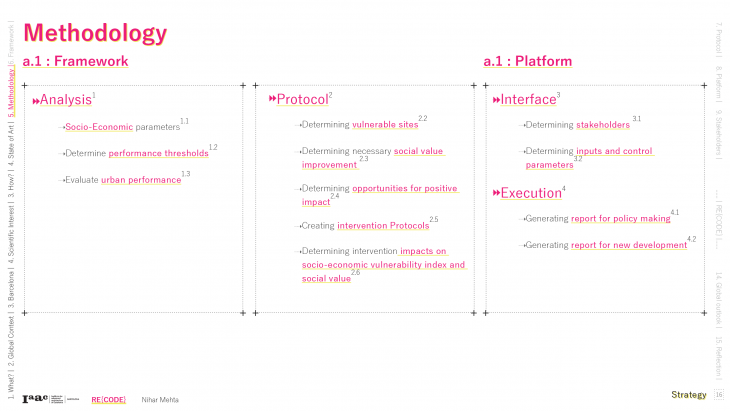
These states of art along with the frameworks helped in the curation of RE{CODE}’s methodology. This involves the analysis of parameters to determine and evaluate urban performance. Protocol to determining vulnerable sites and intervention followed by impact analysis. And lastly creating a platform for the city council’s policymaking and for development agencies to design the interventions.
As the project is based in Barcelona, hints from Barcelona city council’s policies and strategies are used to select the following social and economic parameters to create a particular understanding of performance.
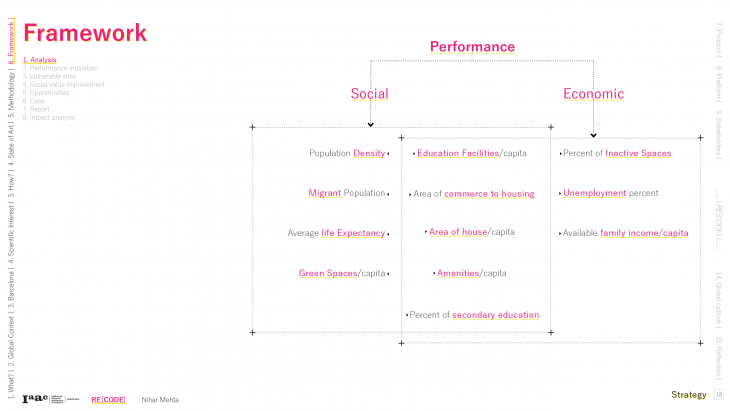
These are measures of density, percentage of migrants, life expectancy, accessibility and availability of green spaces, education facilities, and essential amenities, household area, percentage of inactive spaces, percentage of unemployed and employable population, disposable income, housing to commerce ratio, and percentage population with higher education.
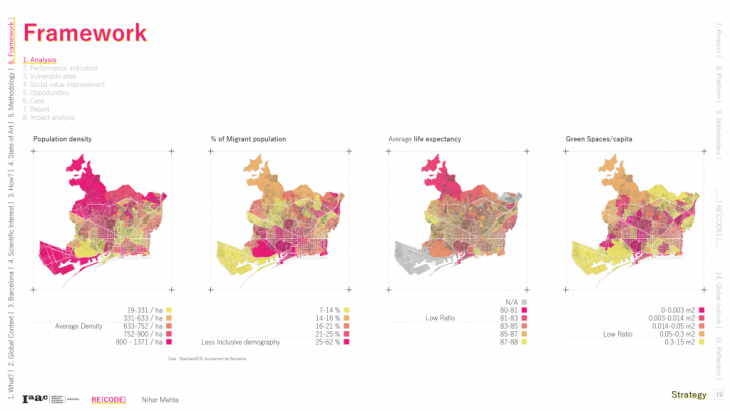
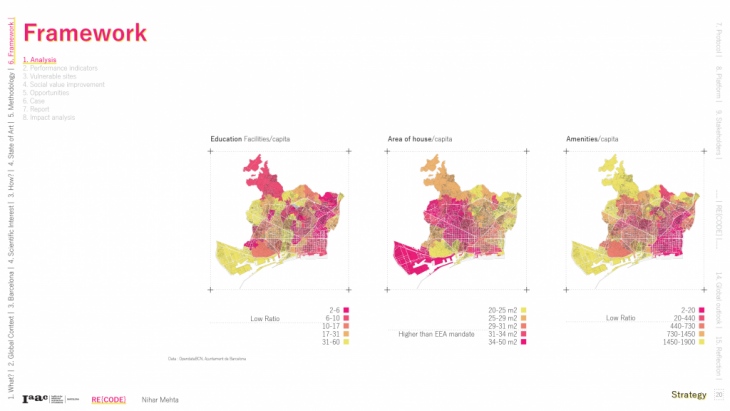
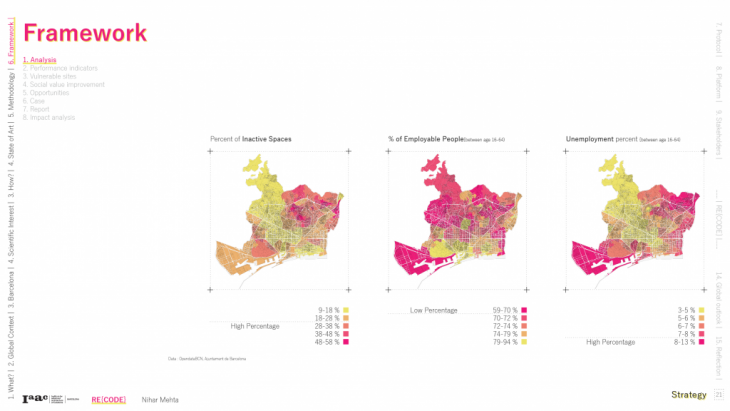
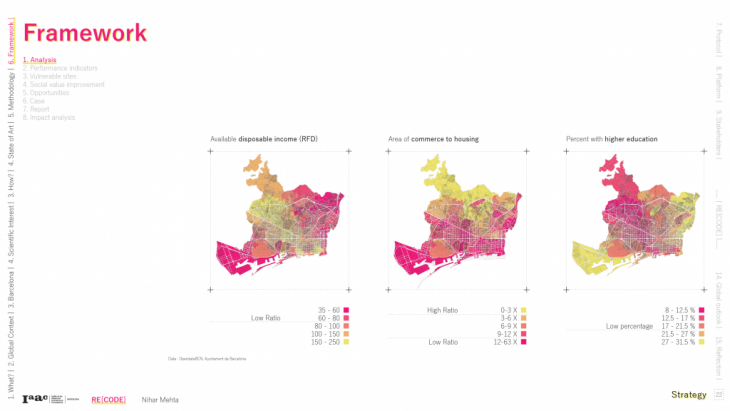
Socio-Economic Vulnerability Index (SEVI)
These indicators are then collapsed into a composite index – The socio-economic vulnerability index.
Although there are many methods to do so, the percentile rank method by CDC is deployed here.
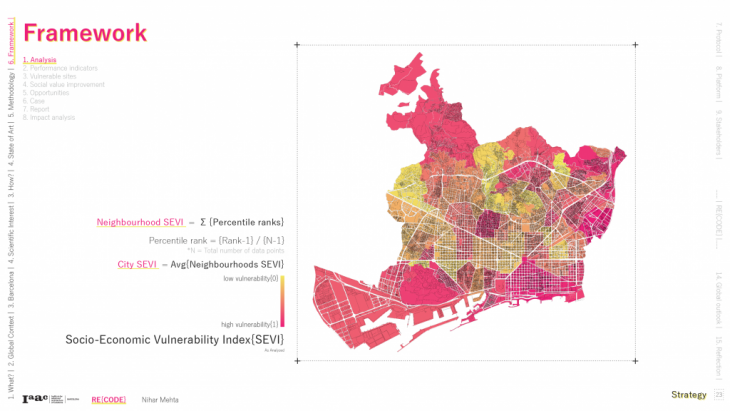
This map helps us understand the different neighborhoods relative to each other, helping the identification of deficient areas.
Performance Evaluation
Alongside the index, the statistical method can further refine this evaluation. Box plotting is used to identify extremes, outliers, and specific deficiencies in neighborhoods. Whereas normal distribution and city council specified values are used to measure the intensity of these deficiencies.
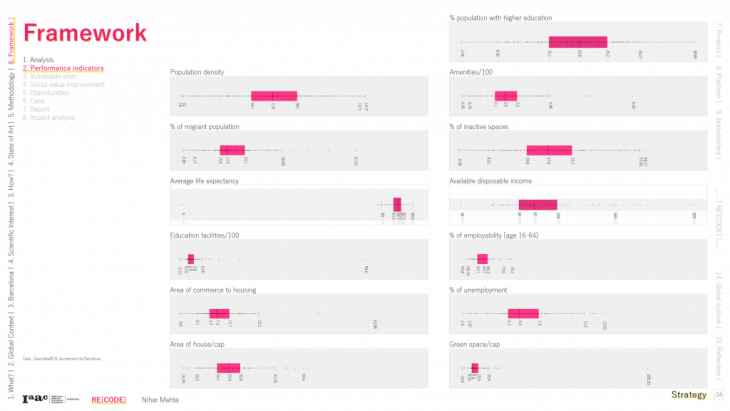
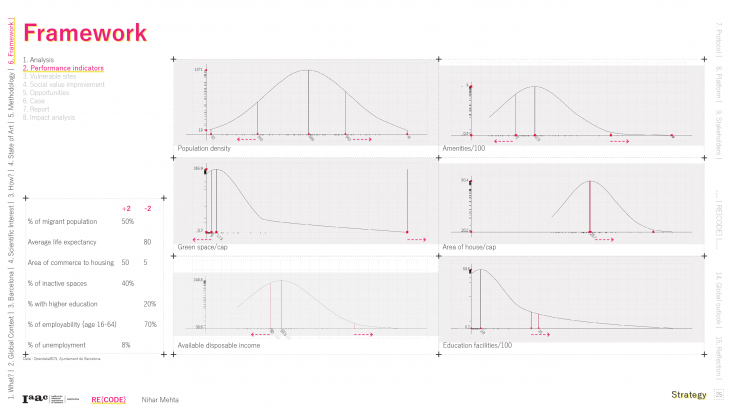
Vulnerable Sites
Analysis over Barcelona reveals a map of vulnerable sites and their deficiencies (against Barcelona’s average).
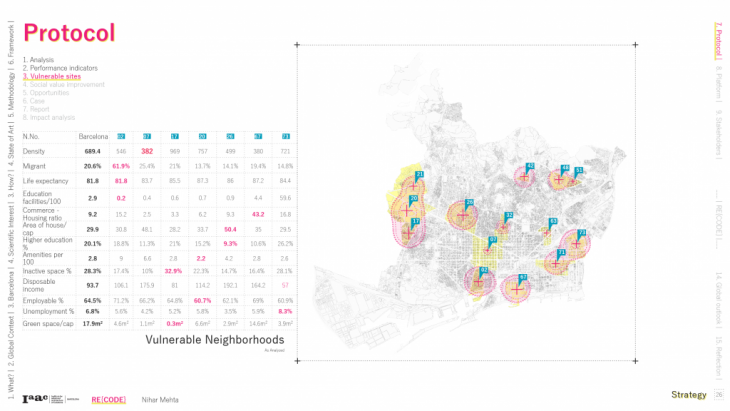
//Re-Development Blocks
Zooming in a scale from neighborhood to block, further analysis is carried to determine the redevelopment potential of blocks. This redevelopment potential measured as a factor of underutilization of a block, in terms of available and existing facilities, amenities, and population density, against the factor of the high cost of operation, considering building age, and cost of maintenance.
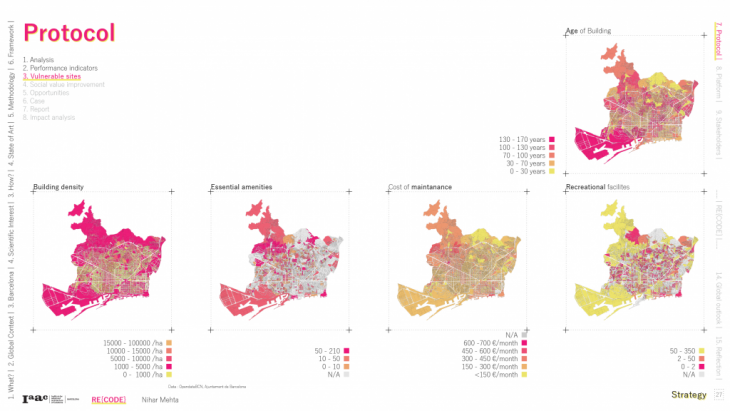
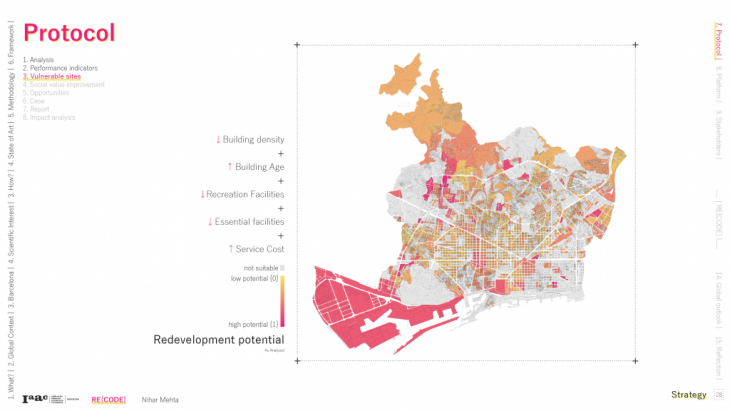

This map shows the redevelopment potential by collapsing the aforementioned indicators, helping the selection of a specific site. And more specifically within the analyzed vulnerable neighborhoods.
//Social Value improvement
We can use these analyses to develop proposals for more socio-economic equality. The approach this project takes is by understanding the value improvement an intervention creates. Based on the parameters that are considered, proposals can be developed to create social-economic, and environmental value through the addition of training opportunities, supporting health and wellbeing, creating jobs for unemployed and less educated populous, investment, and spending on small and medium enterprises.
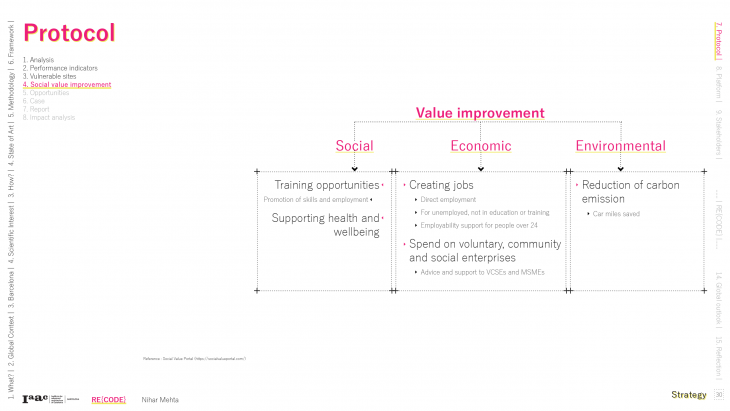
Thus the following catalog of opportunities is made which when implemented can create a better value in the neighborhood, thereby decreasing its deficiencies.

//Case Study
The neighborhood La Verneda i la pau (73) faces gentrification and displacement risks as a result of a new urban transportation hub being constructed next to it, which also has proposed to add high-value homes, retail spaces, and hotels. This would add stress to an already vulnerable population.
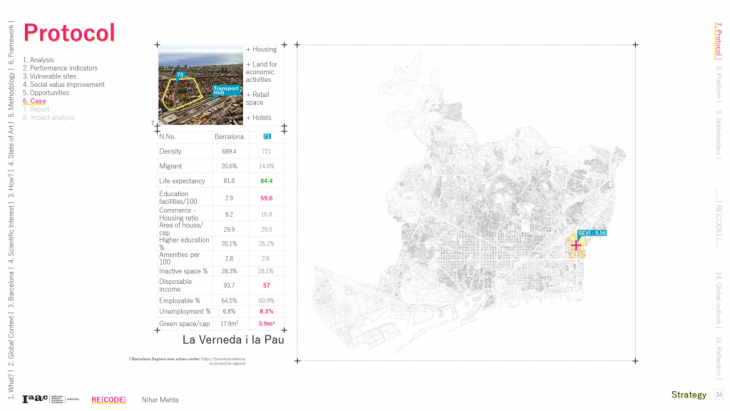
Thus, a proposal created through the methodology would create better social and economic value.
We can check for the blocks with the most potential for redevelopment and select one to evaluate its performance.
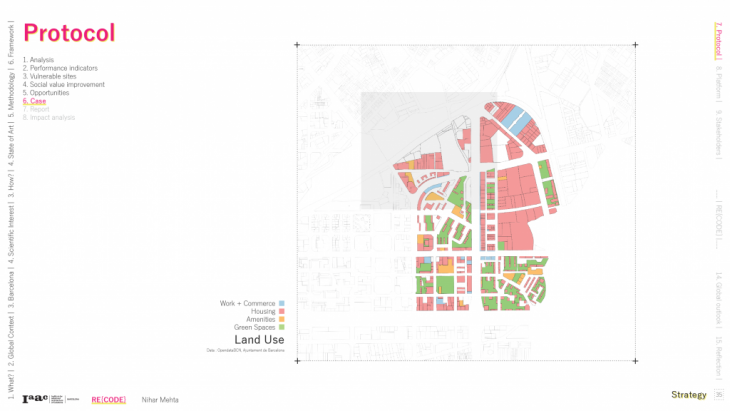
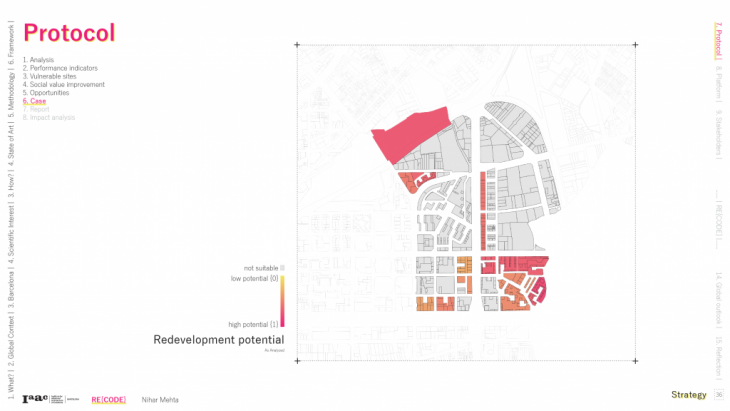
//Intervention Addition
Interventions can be added to the block-based on combinations of deficiencies of the site. This matrix shows different correlations of opportunities as programs with deficiencies that it can tackle.
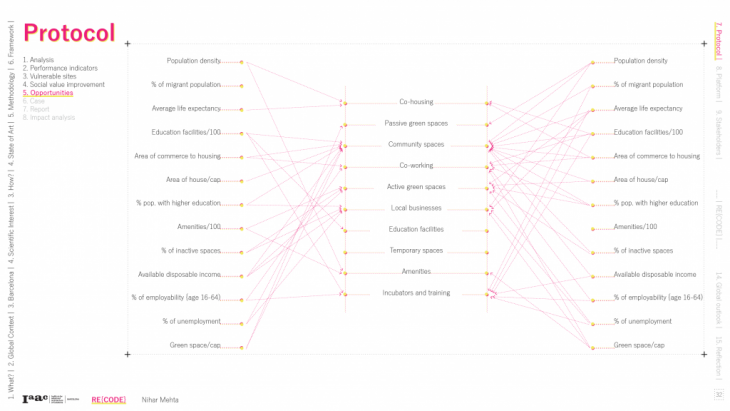
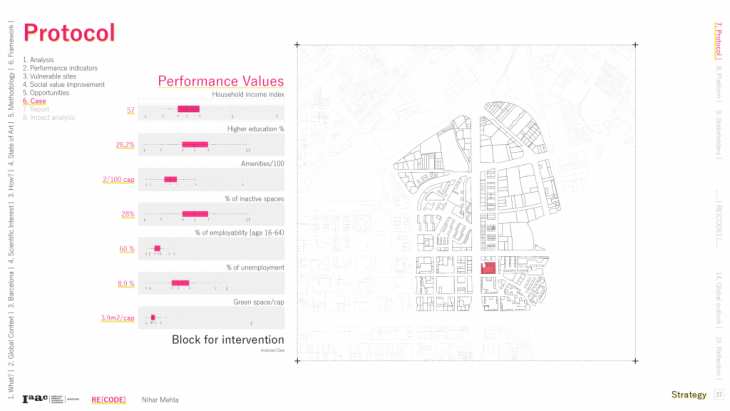
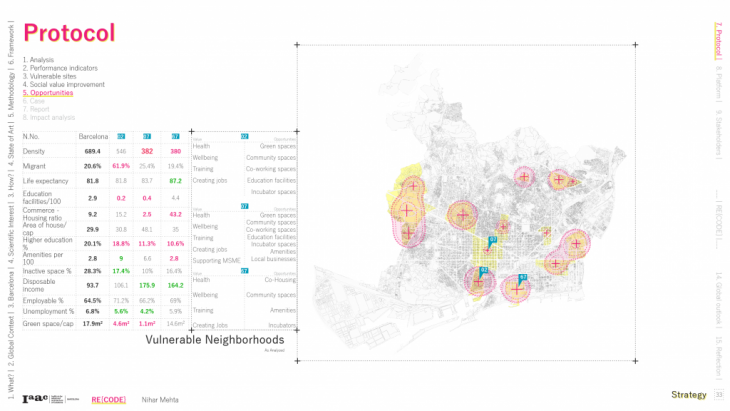
We can create a proposal using the above matrix of correlation.
The vulnerabilities, in this neighborhood 73, direct us to improve job opportunities, improve health and wellbeing, create programs for training and education. Thus by adding the following spaces (refer to image) we can potentially increase the social and economic value and decreasing vulnerability.
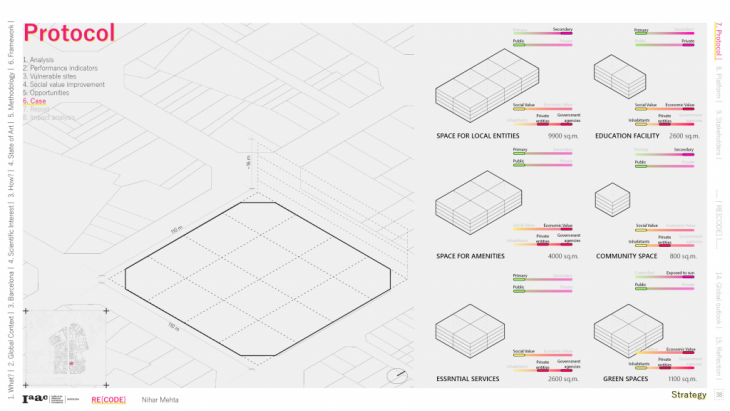
//Value Creation
This value created by the proposal can further be calculated following guidelines by the Social Value Portal.
Along with the economic value, it is important to evaluate the social value in terms of support to people through the creation of opportunities as training, education, health, and wellbeing. Thus, for the selected block, the proposal has the potential to create a positive impact.
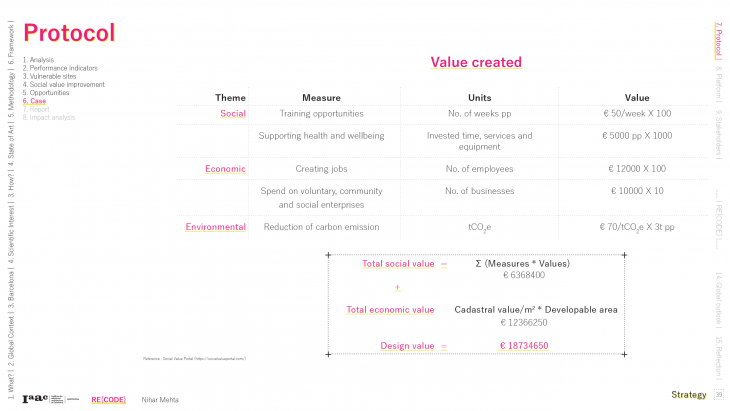
//Report
This proposal is then put into a report to help the city council make planning strategies and policies, and for development stakeholders to design interventions from the proposal.
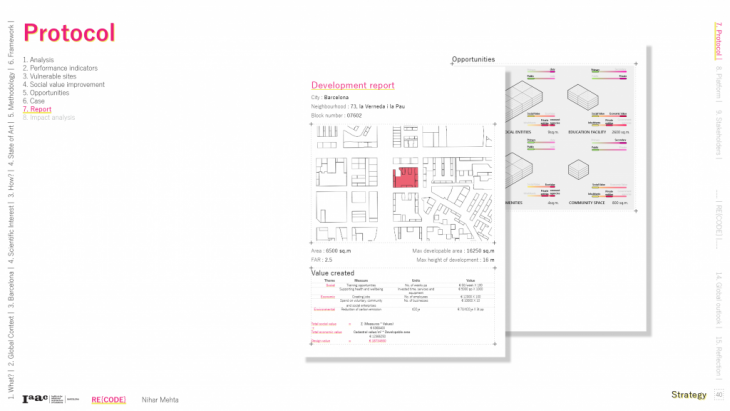
//Impact Analysis
Alongside the value calculations, the proposal is also validated as the impact of interventions on its neighboring areas and on the city’s vulnerability index as a whole. A decreased index overall is a positive proposal.
//Diffusion Algorithm
A diffusion algorithm as a method to check the impact is considered in this project. This is a propagation algorithm where values are iteratively diffused from nodes to neighbors in a network.
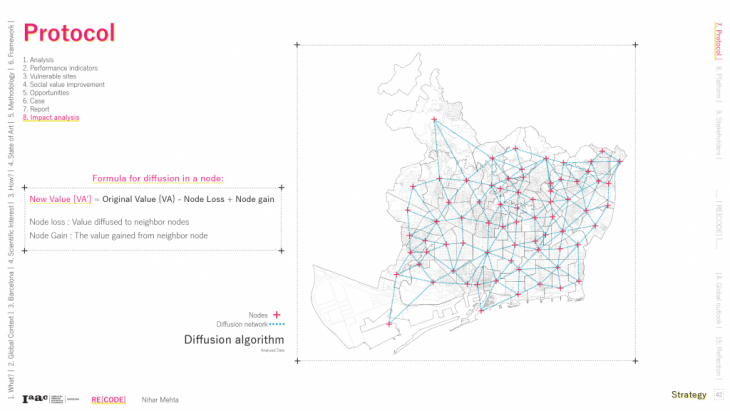
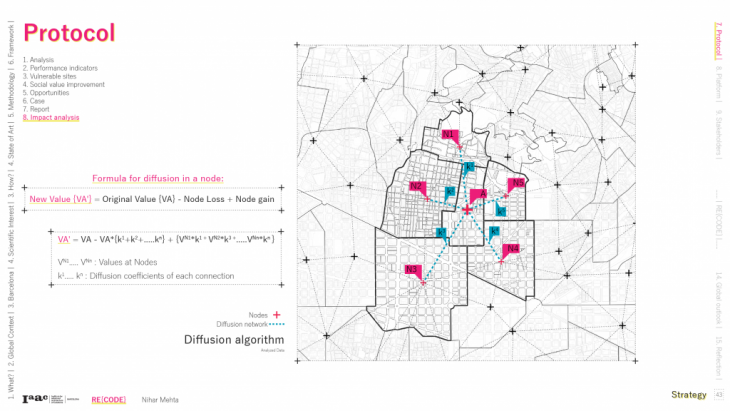
The rate of diffusion between the adjacent neighborhoods is the ratio of changes of each neighborhood.
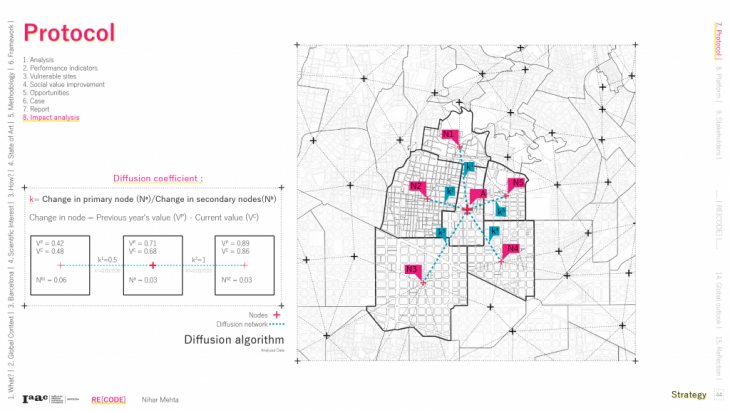
The algorithm derives an altered index for the neighborhood, as well as the city, where the intervention was planned.
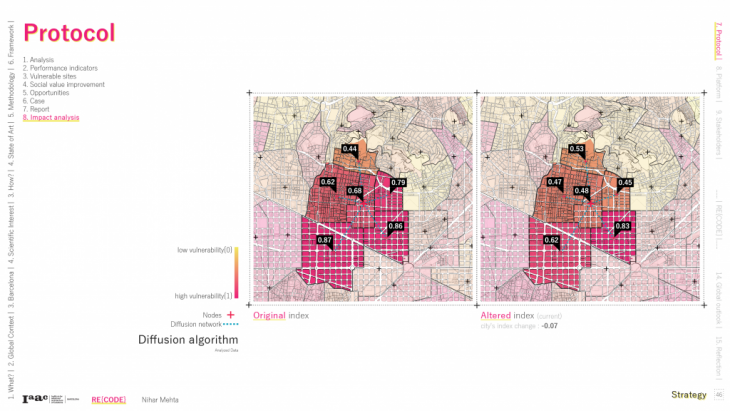
//Projection Data
The methodology so far has evaluated proposals for the vulnerabilities through current data and the current urban situation. Although it is important to understand the impact of these proposals in time, for a better and more informed decision-making process. To do so, a projected dataset is created using regression, in machine learning, with historical data of the selected urban indicators.
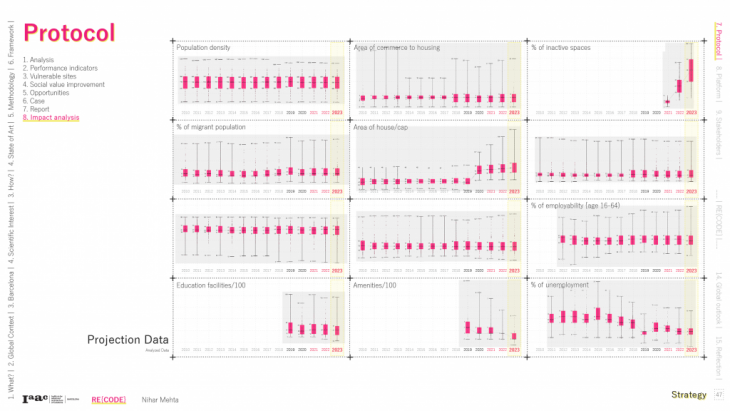
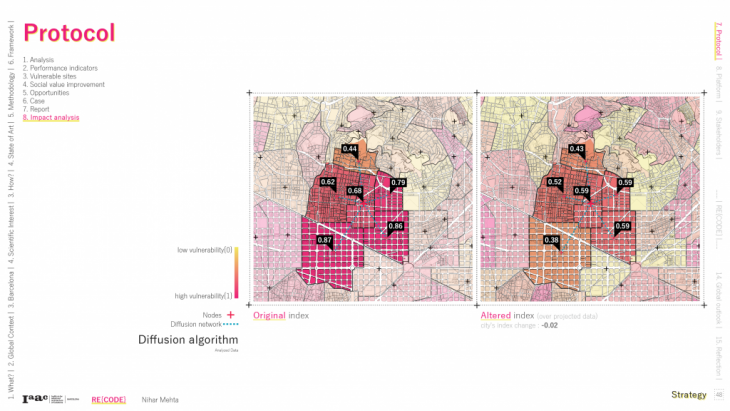
These maps show impact over time helping us alter the initial proposals, which can make the interventions sustainable over time.
//Platform
A digital platform is created to expand the possibilities of this methodology by allowing stakeholders to visualize and plan informed proposals.

//Stakeholder assessment
Different stakeholders can extract information at different scales and resolutions. Primarily city council and planners would get the entire report. Whereas developers would get the value potential of specified interventions and inhabitants will be able to visualize the changes to their neighborhoods.
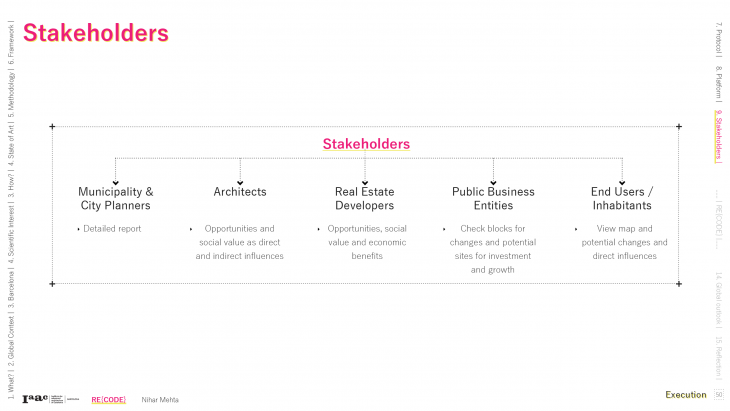
//RE{CODE}
</p>
//Global Outlook
Zooming out and looking back at the issue of gentrification, dispersion, and segregation, improvement of socio-economic parameters in cities has the potential to create a positive impact. Although these parameters are contextual and different for all cities across the world, understanding urban expansion and demographic change in relation to, economic and living patterns can give us insights into future planning policies.
</p>
//Conclusions
Coming back to Barcelona, this strategy of performative redevelopment can affect multiple urban dynamics to create a ripple effect of positive change. And implementing it will allow us to propose opportunities that not only decrease imbalances and inequalities, improve urban performance but also create social, economic, and environmental value for better wellbeing of societies.
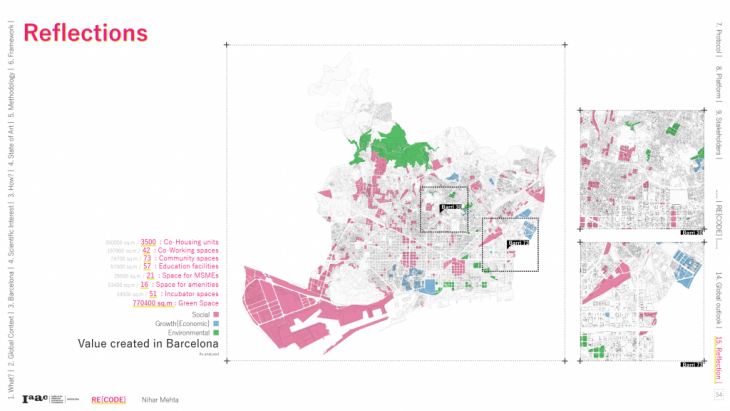
RE{CODE} is a project of IAAC, Institute for Advanced Architecture of Catalonia developed in the MAA02 2019/21 by Student: Nihar Mehta and Faculty: Andrea Graziano & Alessio Erioli